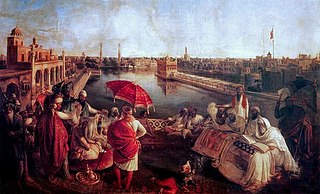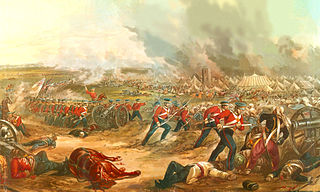
Sikhs are an ethnoreligious group who adhere to Sikhism, a religion that originated in the late 15th century in the Punjab region of the Indian subcontinent, based on the revelation of Guru Nanak. The term Sikh has its origin in the Sanskrit word śiṣya, meaning 'seeker', 'disciple' or 'student'.

The Khalistan movement is a separatist movement seeking to create a homeland for Sikhs by establishing an ethno‐religious sovereign state called Khalistan in the Punjab region. The proposed boundaries of Khalistan vary between different groups; some suggest the entirety of the Sikh-majority Indian state of Punjab, while larger claims include Pakistani Punjab and other parts of North India such as Chandigarh, Haryana, and Himachal Pradesh. Shimla and Lahore have been proposed as the capital of Khalistan.

The Indian Army during British rule, also referred to as the British Indian Army, was the main military force of India until national independence in 1947. Formed in 1895 by uniting the three Presidency Armies, it was responsible for the defence of both British India and the princely states, which could also have their own armies. As stated in the Imperial Gazetteer of India, the "British Government has undertaken to protect the dominions of the Native princes from invasion and even from rebellion within: its army is organized for the defence not merely of British India, but of all possessions under the suzerainty of the King-Emperor." The Indian Army was an important part of the forces of the British Empire, in India and abroad, particularly during the First World War and the Second World War.

The first Anglo-Sikh war was fought between the Sikh Empire and the British East India Company in 1845 and 1846 around the Ferozepur district of Punjab. It resulted in the defeat and partial subjugation of the Sikh empire and cession of Jammu & Kashmir as a separate princely state under British suzerainty.

The second Anglo-Sikh war was a military conflict between the Sikh Empire and the East India Company which took place from 1848 to 1849. It resulted in the fall of the Sikh Empire, and the annexation of the Punjab and what subsequently became the North-West Frontier Province, by the East India Company.

Talwinder Singh Parmar was an Indian militant, Sikh separatist, and the mastermind of the 1985 Air India Flight 182 bombing, which killed 329 people. It was the worst single incident of aviation terrorism in history until the September 11 attacks in the United States. In addition, another bomb was meant to explode aboard Air India Flight 301 in Japan the same day, but it exploded while the plane was still grounded, killing two people. Parmar was also the founder, leader, and Jathedar of Babbar Khalsa International (BKI), better known as Babbar Khalsa, a Sikh militant group involved in the Khalistan movement.

The Komagata Maru incident involved the Japanese steamship Komagata Maru, on which a group of people from British India attempted to migrate to Canada in April 1914, but most were denied entry and forced to return to Budge Budge, near Calcutta. There, the Indian Imperial Police attempted to arrest the group leaders. A riot ensued, and they were fired upon by the police, resulting in some deaths.

A dastār is an item of headwear associated with Sikhism and Sikh culture. The word is loaned from Persian through Punjabi. In Persian, the word dastār can refer to any kind of turban and replaced the original word for turban, dolband (دلبند), from which the English word is derived.
Guran Ditt Kumar, also known as G.D. Kumar Singh, was an Indian revolutionary associated with the pioneers of the Gadhar movement involved in the Indo-German conspiracy during the First World War.

4th Horse (Hodson's Horse) is a part of the Armoured Corps of the Indian Army, which had its beginnings as an irregular cavalry regiment during the time of the Indian Rebellion of 1857.

The Punjab medal was a campaign medal issued to officers and men of the British Army and Honourable East India Company who served in the Punjab campaign of 1848-49, which ended in the British annexation of the Punjab.

Sikhism is the fourth-largest religious group in Canada, with nearly 800,000 adherents, or 2.1% of Canada's population, as of 2021. The largest Sikh populations in Canada are found in Ontario, followed by British Columbia and Alberta. As of the 2021 Census, more than half of Canada's Sikhs can be found in one of four cities: Brampton (163,260), Surrey (154,415), Calgary (49,465), and Edmonton (41,385).

The Sikh Khalsa Army, also known as Khalsaji or simply Sikh Army, was the military force of the Sikh Empire. With its roots in the Khalsa founded by Guru Gobind Singh, the army was later modernised on Franco-British principles by Maharaja Ranjit Singh. It was divided in three wings: the Fauj-i-Khas (elites), Fauj-i-Ain and Fauj-i-Be Qawaid (irregulars). Due to the lifelong efforts of the Maharaja and his European officers, it gradually became a prominent fighting force of Asia. Ranjit Singh changed and improved the training and organisation of his army. He reorganized responsibility and set performance standards in logistical efficiency in troop deployment, manoeuvre, and marksmanship. He reformed the staffing to emphasize steady fire over cavalry and guerrilla warfare, improved the equipment and methods of war. The military system of Ranjit Singh combined the best of both old and new ideas. He strengthened the infantry and the artillery. He paid the members of the standing army from treasury, instead of the Mughal method of paying an army with local feudal levies.

The 1st Horse (Skinner's Horse) is a regiment of the Armoured Corps of the Indian Army. It traces its origins as a cavalry regiment from the times of the East India Company, followed by its service in the British Indian Army and finally, after independence as the fourth oldest and one of the senior cavalry regiments of the Armoured Corps of the Indian Army.
Dave Sukhdip Singh Hayer is a former Indo-Canadian politician for the province of British Columbia. He served as member of the Legislative Assembly (MLA) for Surrey-Tynehead from 2001 to 2013. Hayer is the son of assassinated journalist Tara Singh Hayer.

Indian Canadians are Canadians who have ancestry from India. The term East Indian is sometimes used to avoid confusion with Indigenous groups. Categorically, Indian Canadians comprise a subgroup of South Asian Canadians which is a further subgroup of Asian Canadians. As of the 2021 census, Indians are the second largest non-European ethnic group in the country group after Chinese Canadians and form the fastest growing national origin in Canada. Canada's census only counts citizens and permanent residents, and does not include non-permanent or temporary residents.

Buckam Singh —sometimes spelled Buk Am, Bukam, or Bukkan—was a Indo-Canadian Sikh soldier who served with the Canadian Army in the First World War and early Sikh pioneer to Ontario.

The South Asian community in British Columbia was first established in 1897. The first immigrants originated from Punjab, British India, a northern region and state in modern-day India and Pakistan. Punjabis originally settled in rural British Columbia at the turn of the twentieth century, working in the forestry and agricultural industries.

Harjit Singh Sajjan is an Indian-born Canadian politician and Army veteran who has served as the minister of emergency preparedness and the president of the Privy Council since July 26, 2023. A member of the Liberal Party, Sajjan represents the British Columbia (BC) riding of Vancouver South in the House of Commons, taking office as Member of Parliament (MP) following the 2015 election.

Punjabi Canadians are Canadian citizens of Punjabi descent, numbering approximately 950,000 and accounting for roughly 2.6% of Canada's population, as per the 2021 Canadian census. Their heritage originates wholly or partly from the Punjab region of India and Pakistan.
![Photograph of Kesur Singh [Risaldar-Major] of the 5th Punjab Cavalry, published in The Navy and Army Illustrated, 10 December 1897 Photograph of Kesur Singh, credited as the first Sikh settler of Canada, 10 December 1897.jpg](http://upload.wikimedia.org/wikipedia/commons/thumb/5/5a/Photograph_of_Kesur_Singh%2C_credited_as_the_first_Sikh_settler_of_Canada%2C_10_December_1897.jpg/220px-Photograph_of_Kesur_Singh%2C_credited_as_the_first_Sikh_settler_of_Canada%2C_10_December_1897.jpg)

















